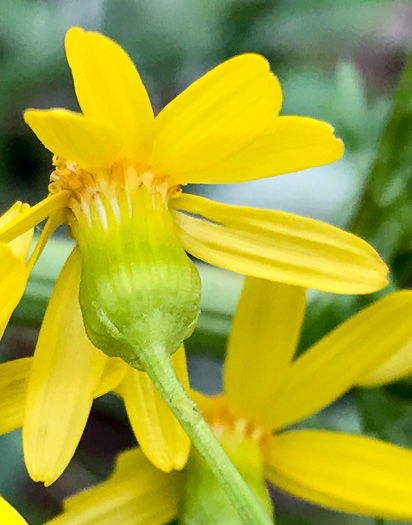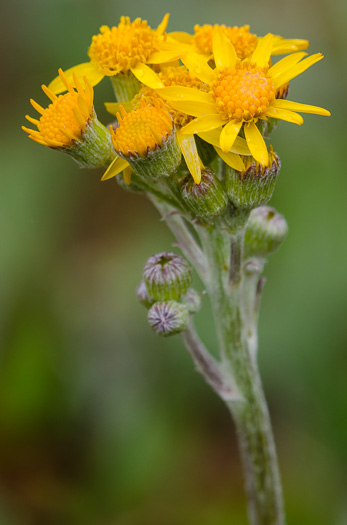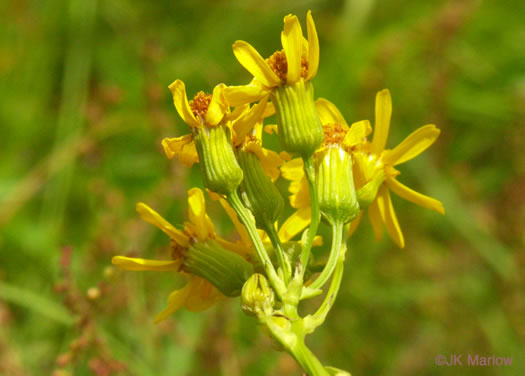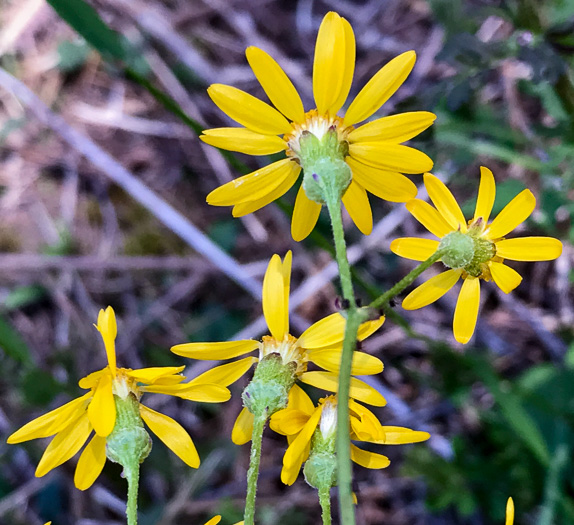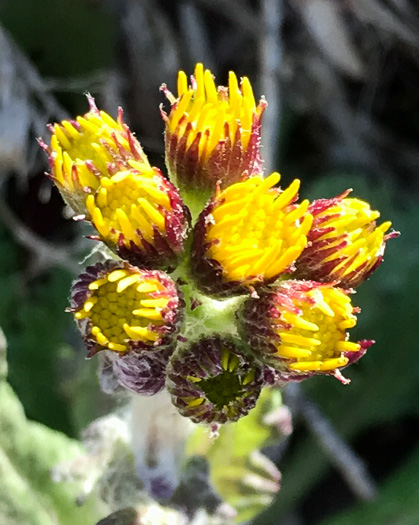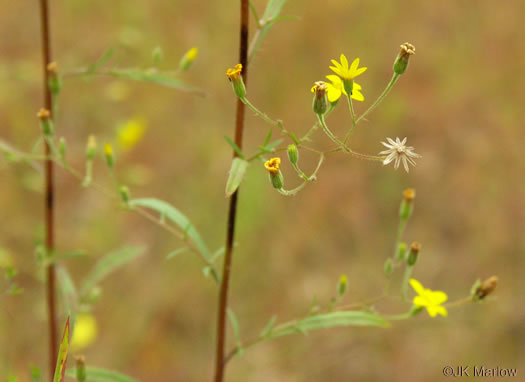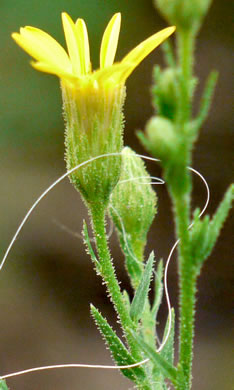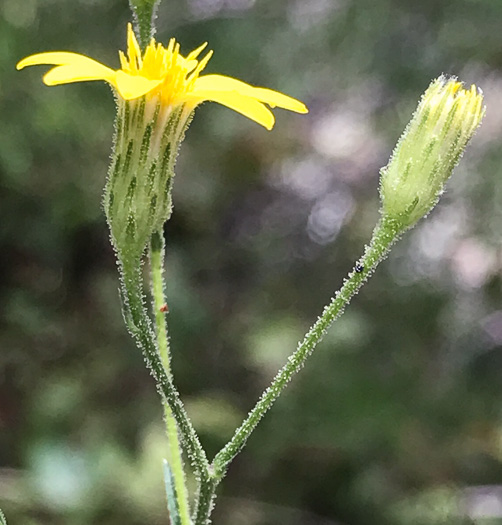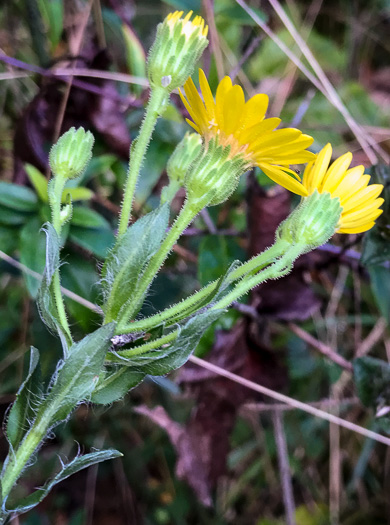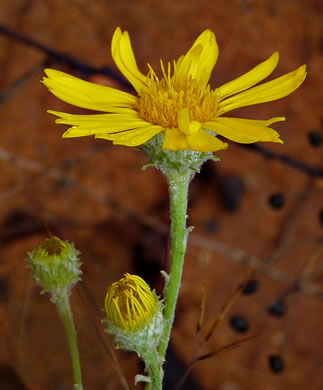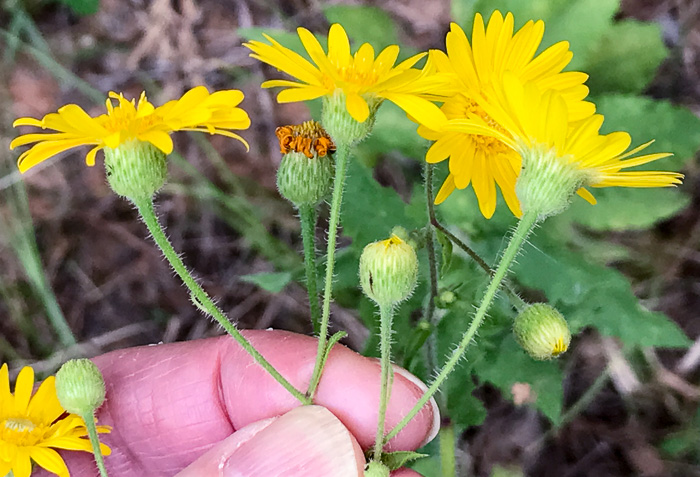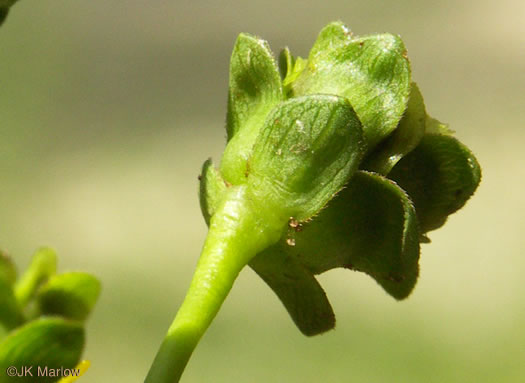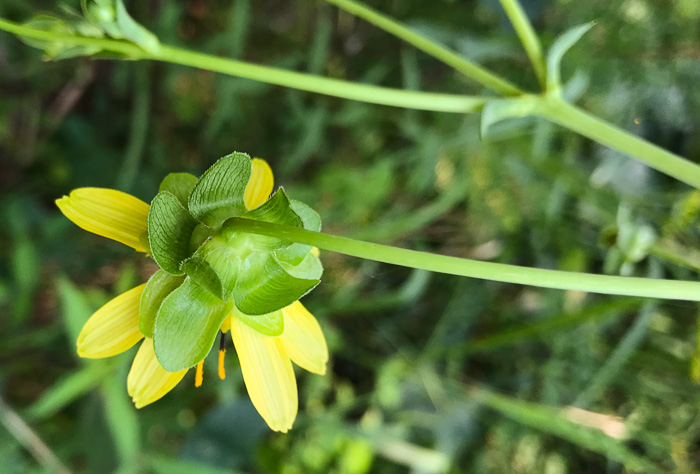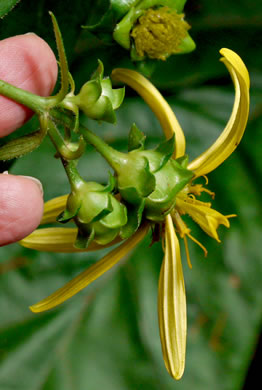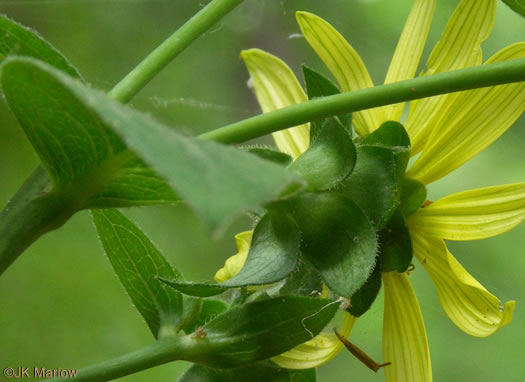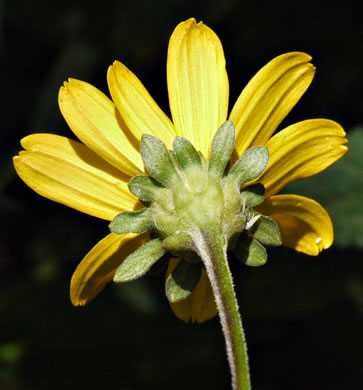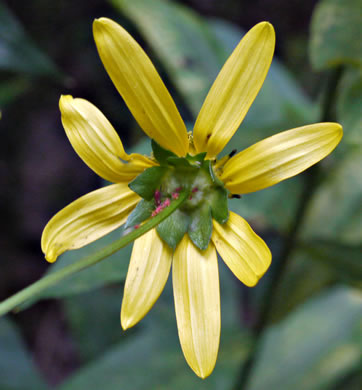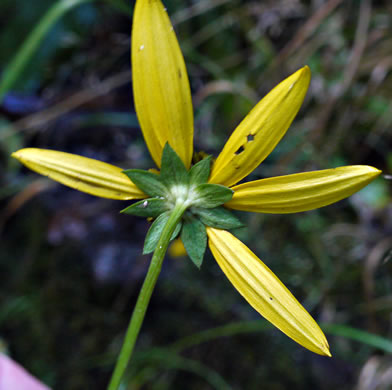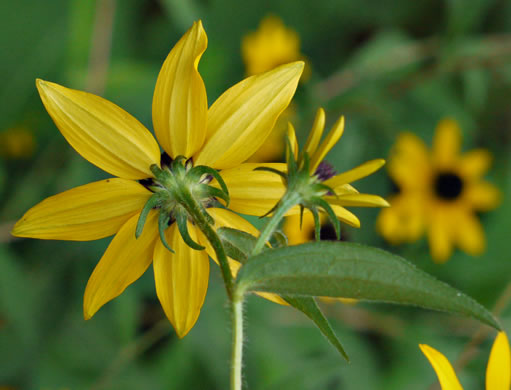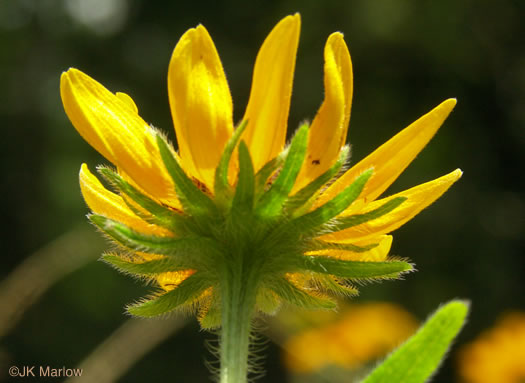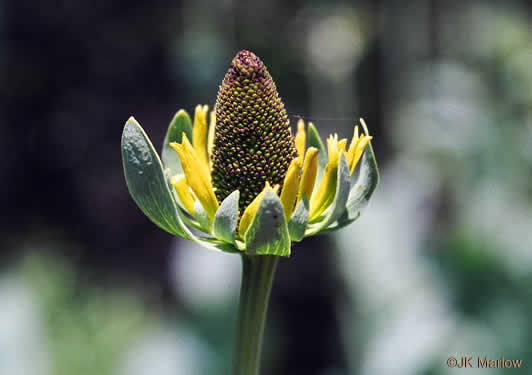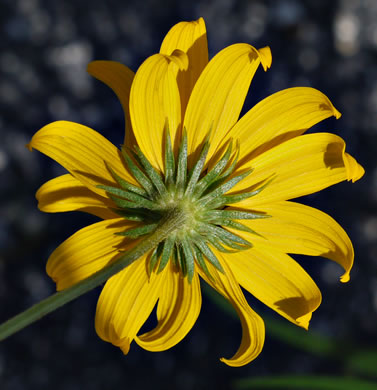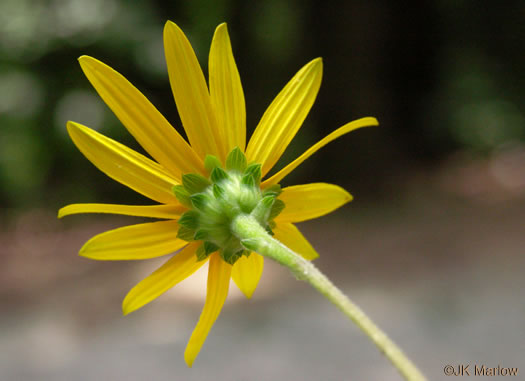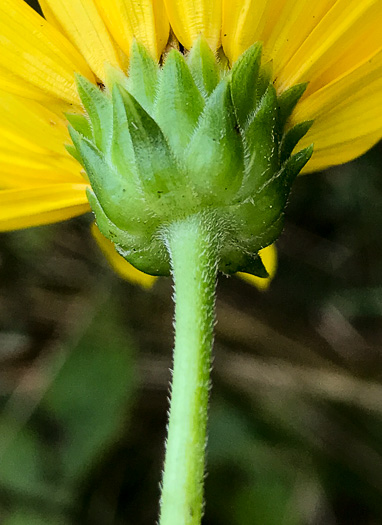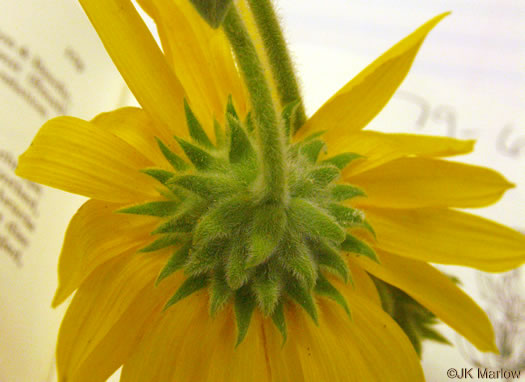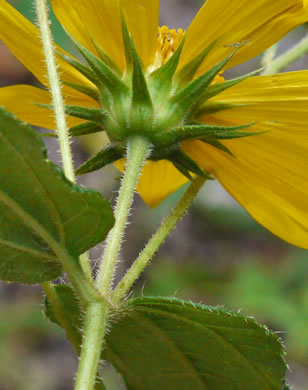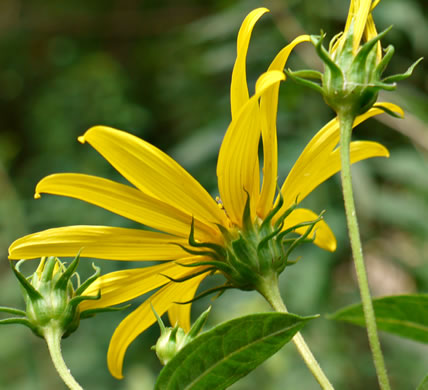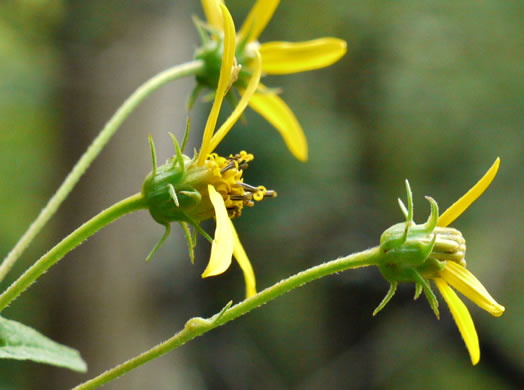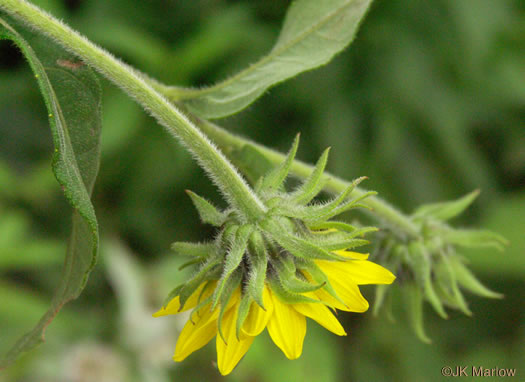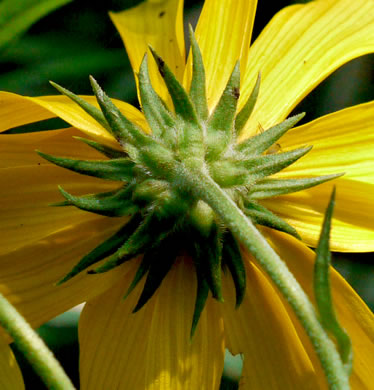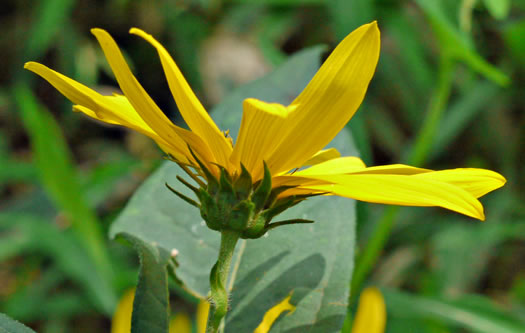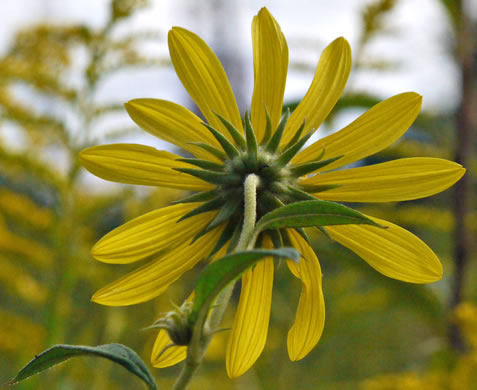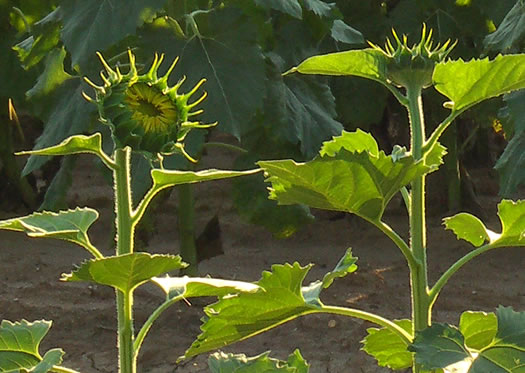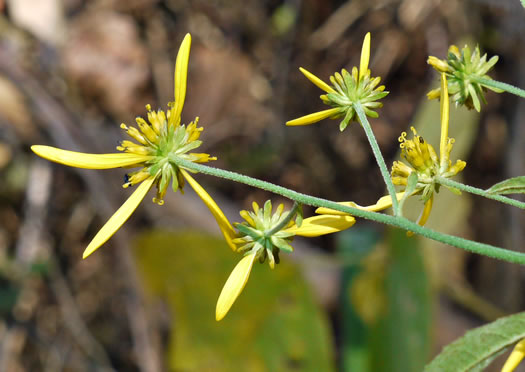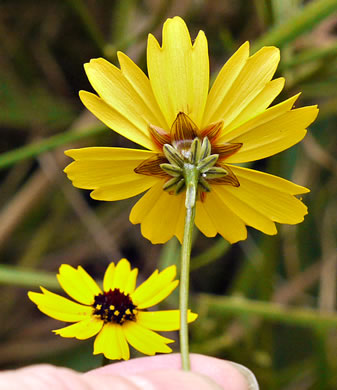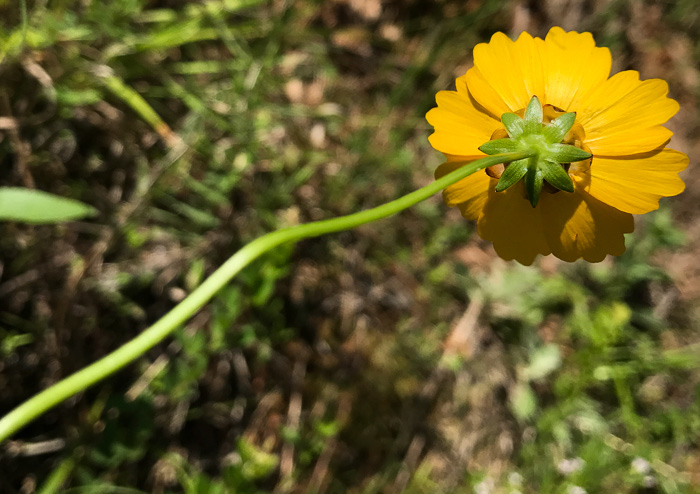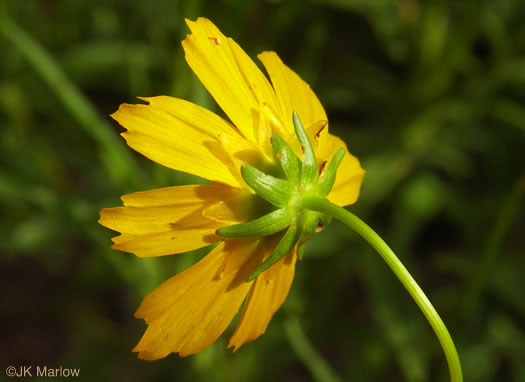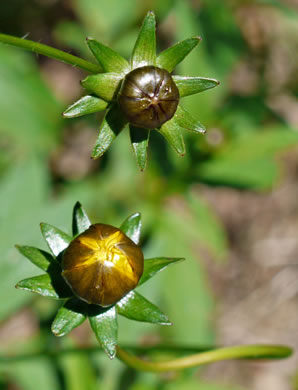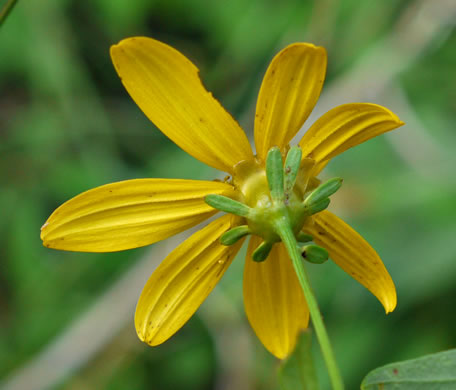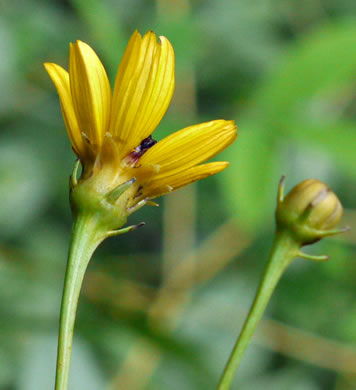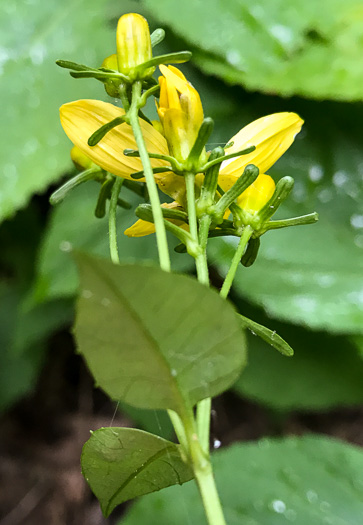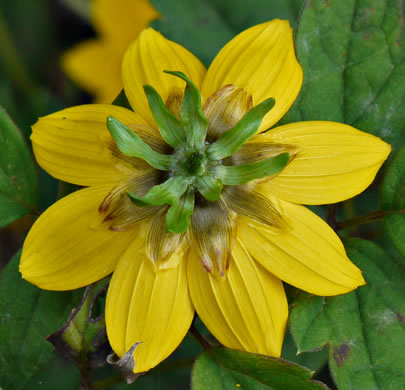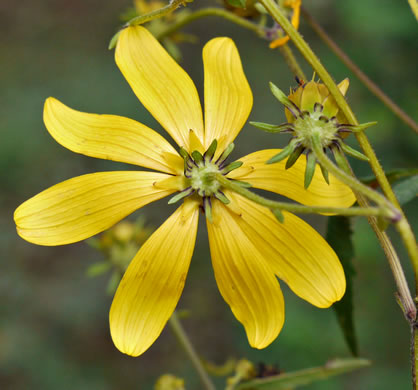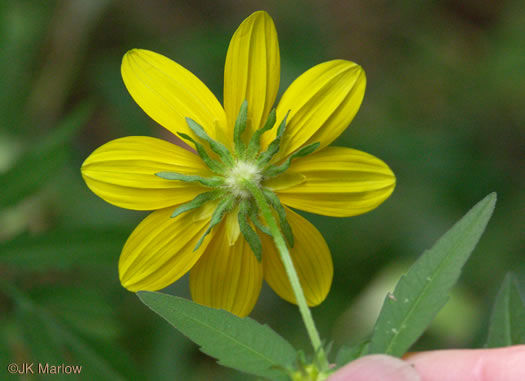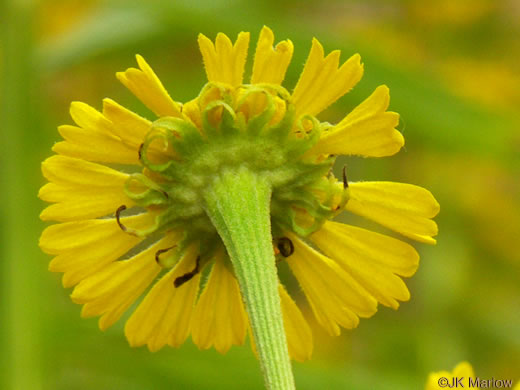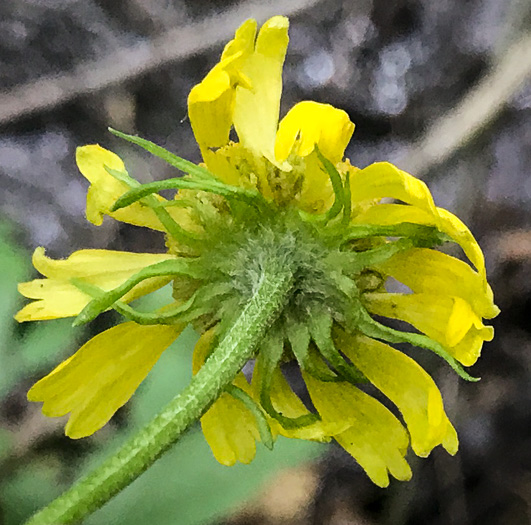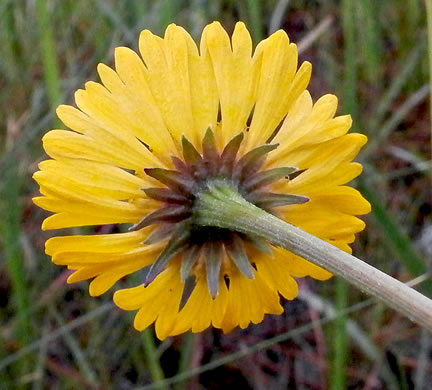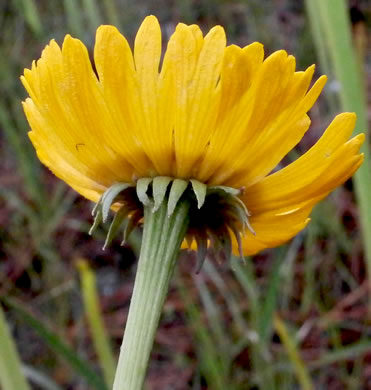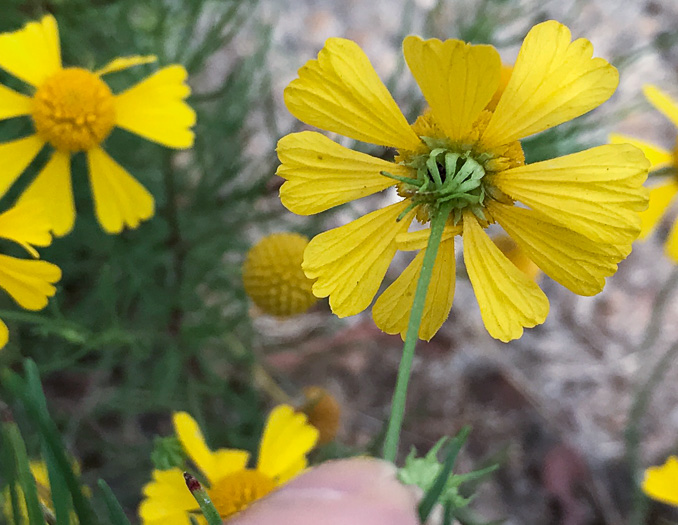Your search found 58 image(s) of involucral bracts of DYCs with ray and disc flowers.
To see larger pictures, click or hover over the thumbnails.
To go to the plant's detail page, click its name.
 Blue Ridge Ragwort,
Packera millefolium
Blue Ridge Ragwort,
Packera millefolium
Phyllaries (13-)21, green, glabrous (tips sometimes hair-tufted), per Flora of North America.
 Woolly Ragwort,
Packera dubia
Woolly Ragwort,
Packera dubia
Phyllaries 13 or 21, light green, usually glabrous(sometimes hairy proximally), per Flora of North America.
 Robbins' Ragwort,
Packera schweinitziana
Robbins' Ragwort,
Packera schweinitziana
Phyllaries 13 or 21, light green (tips sometimes black), 5-8mm, glabrous, per Flora of North America.
 Golden Ragwort,
Packera aurea
Golden Ragwort,
Packera aurea
Phyllaries green (the tips purple or black), per Flora of North America.
 Roundleaf Ragwort,
Packera obovata
Roundleaf Ragwort,
Packera obovata
Involucral bracts purple-tipped, 0.2" [5mm] long, per Wildflowers of Tennessee, the Ohio Valley, and the Southern Appalachians (Horn, Cathcart, Hemmerly, & Duhl, 2005).
 Scratch-daisy,
Croptilon divaricatum
Scratch-daisy,
Croptilon divaricatum
Involucres cylindric to turbinate, 4-6mm long, per Vascular Flora of the Carolinas (Radford, Ahles, & Bell, 1968).
 Carolina Silkgrass,
Pityopsis aspera var. adenolepis
Carolina Silkgrass,
Pityopsis aspera var. adenolepis
Peduncle, upper stem, phyllaries densely glandular-hairy (stipitate-glandular), per Weakley's Flora.
 Carolina Silkgrass,
Pityopsis aspera var. adenolepis
Carolina Silkgrass,
Pityopsis aspera var. adenolepis
Outer to inner phyllaries triangular, usually coarsely stipitate-glandular, per Taxonomic synopsis of Pityopsis (Asteraceae) (Nesom, 2019).
 Common Silkgrass,
Pityopsis nervosa
Common Silkgrass,
Pityopsis nervosa
Peduncles and upper stem eglandular to sparsely glandular, per Weakley's Flora (2020).
 Maryland Goldenaster,
Chrysopsis mariana
Maryland Goldenaster,
Chrysopsis mariana
Bracts stipitate-glandular (as are the peduncles), appressed, per Vascular Flora of the Carolinas (Radford, Ahles, & Bell, 1968).
 Woolly Goldenaster,
Chrysopsis gossypina
Woolly Goldenaster,
Chrysopsis gossypina
More or less densely woolly hairy, except sometime not on involucral bracts, per Guide to the Wildflowers of SC, 1st ed. (Porcher & Rayner, 2001).
 Camphorweed,
Heterotheca subaxillaris
Camphorweed,
Heterotheca subaxillaris
Involucres hemispheric; bracts linear, appressed, stipitate-glandular, per Vascular Flora of the Carolinas (Radford, Ahles, & Bell, 1968).
 Bearsfoot,
Smallanthus uvedalia
Bearsfoot,
Smallanthus uvedalia
Involucral bracts ovate to elliptic, obtuse to acutish, per Vascular Flora of the Carolinas (Radford, Ahles, & Bell, 1968).
 Virginia Cup-plant,
Silphium connatum
Virginia Cup-plant,
Silphium connatum
Involucral bracts of the genus Silphium are wide and usually squarrose, per Vascular Flora of the Carolinas (Radford, Ahles, & Bell, 1968).
 Carolina Rosinweed,
Silphium compositum var. compositum
Carolina Rosinweed,
Silphium compositum var. compositum
Bracts wide, acute or obtuse, glabrous, ciliate or erose, usually squarrose, per Vascular Flora of the Carolinas (Radford, Ahles, & Bell, 1968).
 Ragged Rosinweed,
Silphium reniforme
Ragged Rosinweed,
Silphium reniforme
Bracts wide, acute or obtuse, glabrous, ciliate or erose, usually squarrose, per Vascular Flora of the Carolinas (Radford, Ahles, & Bell, 1968).
 Starry Rosinweed,
Silphium dentatum
Starry Rosinweed,
Silphium dentatum
Involucral bracts of the genus Silphium are wide and usually squarrose, per Vascular Flora of the Carolinas (Radford, Ahles, & Bell, 1968).
 Starry Rosinweed,
Silphium asteriscus var. asteriscus
Starry Rosinweed,
Silphium asteriscus var. asteriscus
Involucral bracts in the genus Silphium are wide and usually squarrose, per Vascular Flora of the Carolinas (Radford, Ahles, & Bell, 1968).
 False Sunflower,
Heliopsis helianthoides var. helianthoides
False Sunflower,
Heliopsis helianthoides var. helianthoides
Bracts oblong, glabrous, cartilaginous w foliaceous, often spreading, apices, per Vascular Flora of the Carolinas (Radford, Ahles, & Bell, 1968).
 Greenheaded Coneflower,
Rudbeckia laciniata var. laciniata
Greenheaded Coneflower,
Rudbeckia laciniata var. laciniata
Involucral bracts lanceolate to oblanceolate, essentially glabrous, acute, per Vascular Flora of the Carolinas (Radford, Ahles, & Bell, 1968).
 Blue Ridge Cutleaf Coneflower,
Rudbeckia laciniata var. humilis
Blue Ridge Cutleaf Coneflower,
Rudbeckia laciniata var. humilis
Involucral bracts lanceolate to oblanceolate, essentially glabrous, acute, per Vascular Flora of the Carolinas (Radford, Ahles, & Bell, 1968).
 Common Eastern Coneflower,
Rudbeckia fulgida
Common Eastern Coneflower,
Rudbeckia fulgida
Phyllaries to 2cm, per Flora of North America.
 Common Three-lobed Coneflower,
Rudbeckia triloba var. triloba
Common Three-lobed Coneflower,
Rudbeckia triloba var. triloba
Involucral bracts linear, 5-12mm long, spreading to reflexed, per Vascular Flora of the Carolinas (Radford, Ahles, & Bell, 1968).
 Woodland Black-eyed Susan,
Rudbeckia hirta var. hirta
Woodland Black-eyed Susan,
Rudbeckia hirta var. hirta
Involucral bracts linear to lanceolate, acute, spreading pubescent, per Vascular Flora of the Carolinas (Radford, Ahles, & Bell, 1968).
 Giant Coneflower,
Rudbeckia maxima
Giant Coneflower,
Rudbeckia maxima
Disc 4-8cm at maturity, per Wildflowers of the Eastern United States (Duncan & Duncan, 1999).
 Narrowleaf Sunflower,
Helianthus angustifolius
Narrowleaf Sunflower,
Helianthus angustifolius
Involucral bracts in several series, lanceolate to linear, acuminate, per Vascular Flora of the Carolinas (Radford, Ahles, & Bell, 1968).
 Purple-disk Sunflower,
Helianthus atrorubens
Purple-disk Sunflower,
Helianthus atrorubens
Phyllaries broadly ovate to oblong, apices obtuse to acute, occ. mucronate, per Flora of North America.
 Showy Sunflower,
Helianthus laetiflorus
Showy Sunflower,
Helianthus laetiflorus
Phyllaries conspicuously graduated and imbricate, usually appressed, per Weakley's Flora.
 Downy Sunflower,
Helianthus mollis
Downy Sunflower,
Helianthus mollis
Involucral bracts lanceolate, acuminate, the tips often reflexed, per Vascular Flora of the Carolinas (Radford, Ahles, & Bell, 1968).
 Hairy Sunflower,
Helianthus hirsutus
Hairy Sunflower,
Helianthus hirsutus
Stem hirsute. Phyllaries lanceolate, usually loose, spreading, not reflexed, per Flora of North America.
 Thinleaf Sunflower,
Helianthus decapetalus
Thinleaf Sunflower,
Helianthus decapetalus
Longer phyllaries usually exceeding disk by half their length+, apex acuminate, per Weakley's Flora.
 Small Wood Sunflower,
Helianthus microcephalus
Small Wood Sunflower,
Helianthus microcephalus
Involucres 0.7-1cm long, bracts lanceolate, usually spreading apically, per Vascular Flora of the Carolinas (Radford, Ahles, & Bell, 1968).
 Hairy Sunflower,
Helianthus resinosus
Hairy Sunflower,
Helianthus resinosus
Involucres 3-5cm broad; bracts lanceolate, acuminate, spreading, per Vascular Flora of the Carolinas (Radford, Ahles, & Bell, 1968).
 Jerusalem Artichoke,
Helianthus tuberosus
Jerusalem Artichoke,
Helianthus tuberosus
Phyllaries lanceolate, subequal, apices acuminate, per Flora of North America.
 Jerusalem Artichoke,
Helianthus tuberosus
Jerusalem Artichoke,
Helianthus tuberosus
Base of phyllaries appressed, apices ± spreading (sometimes reflexed in fruit), per Flora of North America.
 Tall Sunflower,
Helianthus giganteus
Tall Sunflower,
Helianthus giganteus
Phyllaries not conspicuously graduated & imbricate, usually loose or spreading, per Weakley's Flora.
 Common Sunflower,
Helianthus annuus
Common Sunflower,
Helianthus annuus
Involucral body 2-10cm+ broad; bracts ovate abruptly long-acuminate, spreading, per Vascular Flora of the Carolinas (Radford, Ahles, & Bell, 1968).
 Common Wingstem,
Verbesina alternifolia
Common Wingstem,
Verbesina alternifolia
Phyllaries in 1(-2) series, ~ spreading to reflexed, per Flora of North America.
 Southern Crownbeard,
Verbesina occidentalis
Southern Crownbeard,
Verbesina occidentalis
Phyllaries in 2 series, more or less erect, per Flora of North America.
 Swamp Coreopsis,
Coreopsis gladiata
Swamp Coreopsis,
Coreopsis gladiata
Outer phyllaries lanceolate, 0.4-0.8X as long as the inner phyllaries, per Weakley's Flora (2023).
 Lanceleaf Coreopsis,
Coreopsis lanceolata
Lanceleaf Coreopsis,
Coreopsis lanceolata
Outer involucral bracts green, lanceolate; inner elliptic to lanceolate, per Vascular Flora of the Carolinas (Radford, Ahles, & Bell, 1968).
 Large-flowered Coreopsis,
Coreopsis grandiflora var. grandiflora
Large-flowered Coreopsis,
Coreopsis grandiflora var. grandiflora
Outer involucral bracts green, lanceolate; inner eliptic to lanceolate, per Vascular Flora of the Carolinas (Radford, Ahles, & Bell, 1968).
 Common Hairy Coreopsis,
Coreopsis pubescens var. pubescens
Common Hairy Coreopsis,
Coreopsis pubescens var. pubescens
Here the outer phyllaries are spreading, the inner just beginning to open.
 Common Hairy Coreopsis,
Coreopsis pubescens var. pubescens
Common Hairy Coreopsis,
Coreopsis pubescens var. pubescens
Calyculi [outer involucral bracts] of lanceolate to lance-linear bractlets, per Flora of North America.
 Eared Coreopsis,
Coreopsis auriculata
Eared Coreopsis,
Coreopsis auriculata
Outer bracts lanceolate, 6-10 mm long; inner lanceolate to elliptic, 7-13mm, per Vascular Flora of the Carolinas (Radford, Ahles, & Bell, 1968).
 Whorled Coreopsis,
Anacis major
Whorled Coreopsis,
Anacis major
Coreopsis major var. rigida: Outer phyllaries slightly short-pubescent to glabrous, per Weakley's Flora (2015).
 Whorled Coreopsis,
Anacis major
Whorled Coreopsis,
Anacis major
Coreopsis major var. major: Outer phyllaries rather densely short-pubescent, per Weakley's Flora (2015).
 Tall Coreopsis,
Anacis tripteris
Tall Coreopsis,
Anacis tripteris
Outer involucral bracts linear, 3-6mm long: inner lanceolate, 4-7mm long, per Vascular Flora of the Carolinas (Radford, Ahles, & Bell, 1968).
 Broadleaf Tickseed,
Silphidium latifolium
Broadleaf Tickseed,
Silphidium latifolium
Outer involucral bracts linear, 4-6mm long: inner lanceolate, 7-8mm long, per Vascular Flora of the Carolinas (Radford, Ahles, & Bell, 1968).
 Nodding Bur-marigold,
Bidens cernua
Nodding Bur-marigold,
Bidens cernua
Outer involucral bracts leafy, typically surpassing the disk, per Wildflowers of Tennessee, the Ohio Valley, and the Southern Appalachians (Horn, Cathcart, Hemmerly, & Duhl, 2005).
 Ditch Daisy,
Bidens aristosa
Ditch Daisy,
Bidens aristosa
Outer involucral bracts shorter than the inner, fewer than B. polylepis, per Wildflowers of Tennessee (Carman, 2005).
 Ditch Daisy,
Bidens polylepis
Ditch Daisy,
Bidens polylepis
Outer involucral bracts curled and twisted, and longer than inner bracts, per Wildflowers of Tennessee, the Ohio Valley, and the Southern Appalachians (Horn, Cathcart, Hemmerly, & Duhl, 2005).
 Spanish Needles,
Bidens bipinnata
Spanish Needles,
Bidens bipinnata
Outer bracts green, 2-7mm long, very narrow; inner 4-8mm long, per Vascular Flora of the Carolinas (Radford, Ahles, & Bell, 1968).
 Common Sneezeweed,
Helenium autumnale
Common Sneezeweed,
Helenium autumnale
Involucre of one series of linear bracts, 5-10mm long, per Vascular Flora of the Carolinas (Radford, Ahles, & Bell, 1968).
 Savannah Sneezeweed,
Helenium vernale
Savannah Sneezeweed,
Helenium vernale
Peduncles usually glabrous, sometimes sparsely hairy; cypselae glabrous, per Flora of North America.
 Savannah Sneezeweed,
Helenium vernale
Savannah Sneezeweed,
Helenium vernale
Involucre of one series of linear bracts, per Vascular Flora of the Carolinas (Radford, Ahles, & Bell, 1968).
 Bitterweed,
Helenium amarum
Bitterweed,
Helenium amarum
Involucre one series of linear bracts, per Vascular Flora of the Carolinas (Radford, Ahles, & Bell, 1968).

